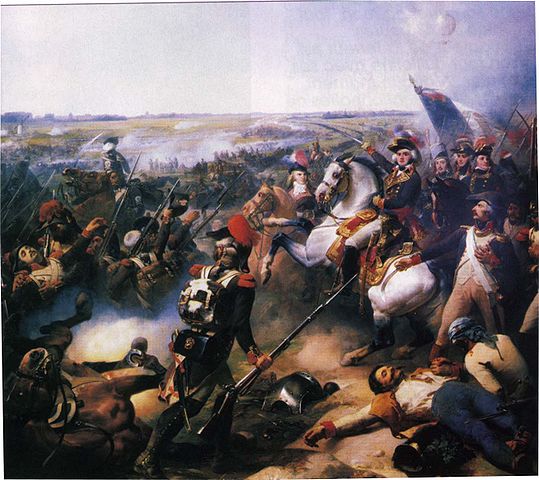|
|||
|
Philatelia.Net / French revolution / Plots / The directory «Plots»Victory at FleurusIn the Battle of Fleurus on 26 June 1794, the army of the First French Republic under General Jean-Baptiste Jourdan faced the Coalition Army (Great Britain, Hanover, Dutch Republic, and Habsburg Monarchy) commanded by Prince Josias of Coburg in the most decisive battle of the Flanders Campaign in the Low Countries during the French Revolutionary Wars. Both sides had forces in the area numbering in the vicinity of 80,000 men, but the French were able to more effectively concentrate their troops in order to achieve victory against the First Coalition. The Allied defeat led to the permanent loss of the Austrian Netherlands and to the destruction of the Dutch Republic. The battle marked a turning point for the French army which afterwards remained ascendant throughout the rest of the War of the First Coalition. The French use of the reconnaissance balloon l'Entreprenant marked the first military use of an aircraft that had decisive influence on the outcome of the battle. After the Battle of Tourcoing on 17-18 May 1794, Jourdan was given the command of the Army of the Ardennes and four divisions of the Army of the North, about 96,000 men in total. This new group was then named the Army of the Sambre-et-Meuse. The new army was then given the task of capturing Charleroi. On 12 June, the French army, accompanied and supervised by a member of the Committee of Public Safety, Louis de Saint-Just, had invested the town of Charleroi with about 70,000 men. On 16 June at Lambusart, an Austrian-Dutch force of about 43,000 men counterattacked in heavy mist. The Allies managed to inflict some 3,000 casualties on the French and drive them back over the Sambre. On 18 June, however, Jourdan attacked again and managed to retake Charleroi. The city surrendered on 26 June, just as a relieving force under the Prince of Coburg arrived to raise the siege. On 26 June, Feldmarschall Coburg manœuvred around Charleroi with 52,000 Austrians and Netherlanders. Too late to save the city, which had surrendered, the Austrian commander split his army into five columns and attacked the French. A French reconnaissance balloon, l'Entreprenant, operated by the Aerostatic Corps, continuously informed General of Division (MG) Jean-Baptiste Jourdan about Austrian movements. The Austrians managed to break through both French wings, pushing back MG François Marceau on the right wing and MG Montaigu on the left wing. But the French center under MG François Lefebvre held and then counterattacked, and the Austrian assault petered out. Colonel Nicolas Soult, then serving as Lefebvre's Chief of staff, wrote that it was, "fifteen hours of the most desperate fighting I ever saw in my life." Coburg neglected to press on and, uncertain of the outcome, the Austrian commander lost his nerve and fell back to Braine-l'Alleud and Waterloo, granting the French an unexpected victory. This was the final straw that caused the allies to retire back over the Rhine, leaving the French free rein in Belgium and the Netherlands. Smith writes that, "By this stage of the war the court in Vienna was convinced that it was no longer worth the effort to try to keep their Netherlands provinces and it is suspected that Coburg gave up the chance of a victory here so as to be able to pull out eastwards." It is generally agreed that the battle was a costly one for the French, with casualties estimated between five and six thousand. The Allied losses have always been in dispute: the French claimed significantly higher losses than their own, while the Allies claimed far less. Traditional estimates attribute "considerable casualties" to Coburg's army, and hover near five thousand Allied killed and wounded. However, according to historian Digby Smith, Austrian-Dutch losses numbered 208 killed, 1,017 wounded, and 361 captured. In addition, the French captured one mortar, three caissons, and one standard, while the Austrians captured one cannon and one standard. Despite any tactical imbalance, the strategic value of Fleurus was immense for the French. The victory precipitated a full Allied withdrawal from Belgium and allowed French forces to push north into the Netherlands. By the end of 1795, the Dutch Republic was extinguished. After Fleurus, the republican army would keep its momentum in the war, staying on the offensive until its eventual victory against the First Coalition in 1797. Politically, the battle invalidated the argument that continuation of the revolutionary Reign of Terror was necessary because of the military threat to France's very existence. Thus, some would argue, victory at Fleurus was a leading cause of 9 Thermidor a month later. Saint-Just arrived in Paris after such a great victory only to die with Maximilien Robespierre and the other leading Jacobins in the Thermidorian Reaction. Central African Republic, 1989, Marchal Jourdan, Battle at Flerus Advertising: |
|||
© 2003-2024 Dmitry Karasyuk. Idea, preparation, drawing up
|

